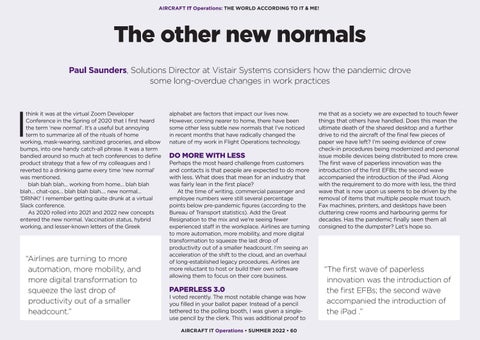AIRCRAFT IT Operations: THE WORLD ACCORDING TO IT & ME!
The other new normals Paul Saunders, Solutions Director at Vistair Systems considers how the pandemic drove some long-overdue changes in work practices
I
think it was at the virtual Zoom Developer Conference in the Spring of 2020 that I first heard the term ‘new normal’. It’s a useful but annoying term to summarize all of the rituals of home working, mask-wearing, sanitized groceries, and elbow bumps, into one handy catch-all phrase. It was a term bandied around so much at tech conferences to define product strategy that a few of my colleagues and I reverted to a drinking game every time ‘new normal’ was mentioned. blah blah blah... working from home… blah blah blah… chat-ops… blah blah blah…. new normal… ‘DRINK!’ I remember getting quite drunk at a virtual Slack conference. As 2020 rolled into 2021 and 2022 new concepts entered the new normal. Vaccination status, hybrid working, and lesser-known letters of the Greek
“Airlines are turning to more automation, more mobility, and more digital transformation to squeeze the last drop of productivity out of a smaller headcount.”
alphabet are factors that impact our lives now. However, coming nearer to home, there have been some other less subtle new normals that I’ve noticed in recent months that have radically changed the nature of my work in Flight Operations technology.
DO MORE WITH LESS
Perhaps the most heard challenge from customers and contacts is that people are expected to do more with less. What does that mean for an industry that was fairly lean in the first place? At the time of writing, commercial passenger and employee numbers were still several percentage points below pre-pandemic figures (according to the Bureau of Transport statistics). Add the Great Resignation to the mix and we’re seeing fewer experienced staff in the workplace. Airlines are turning to more automation, more mobility, and more digital transformation to squeeze the last drop of productivity out of a smaller headcount. I’m seeing an acceleration of the shift to the cloud, and an overhaul of long-established legacy procedures. Airlines are more reluctant to host or build their own software allowing them to focus on their core business.
PAPERLESS 3.0
I voted recently. The most notable change was how you filled in your ballot paper. Instead of a pencil tethered to the polling booth, I was given a singleuse pencil by the clerk. This was additional proof to AIRCRAFT IT Operations • SUMMER 2022 • 60
me that as a society we are expected to touch fewer things that others have handled. Does this mean the ultimate death of the shared desktop and a further drive to rid the aircraft of the final few pieces of paper we have left? I’m seeing evidence of crew check-in procedures being modernized and personal issue mobile devices being distributed to more crew. The first wave of paperless innovation was the introduction of the first EFBs; the second wave accompanied the introduction of the iPad. Along with the requirement to do more with less, the third wave that is now upon us seems to be driven by the removal of items that multiple people must touch. Fax machines, printers, and desktops have been cluttering crew rooms and harbouring germs for decades. Has the pandemic finally seen them all consigned to the dumpster? Let’s hope so.
“The first wave of paperless innovation was the introduction of the first EFBs; the second wave accompanied the introduction of the iPad .”




